Related Research Articles

Mestizo is a person of mixed European and indigenous non-European ancestry in the former Spanish Empire. In certain regions such as Latin America, it may also refer to people who are culturally European even though their ancestors are indigenous. The term was used as an ethno-racial exonym for mixed-race castas that evolved during the Spanish Empire. It was a formal label for individuals in official documents, such as censuses, parish registers, Inquisition trials, and others. Priests and royal officials might have classified persons as mestizos, but individuals also used the term in self-identification.

The Nahua are an Indigenous group of Mesoamerican people inhabiting the western and central areas of present-day El Salvador. They speak the Nawat language, which belongs to the Nahuan language branch of the Uto-Aztecan language family. There are very few speakers of the language left, which is a reason for the current efforts being made to revitalize it.
Latin Americans are the citizens of Latin American countries.

The Oto-Manguean or Otomanguean languages are a large family comprising several subfamilies of indigenous languages of the Americas. All of the Oto-Manguean languages that are now spoken are indigenous to Mexico, but the Manguean branch of the family, which is now extinct, was spoken as far south as Nicaragua and Costa Rica. Oto-Manguean is widely viewed as a proven language family. However, this status has been recently challenged.

Maná is a Mexican pop-rock band. Formed in 1981 as Sombrero Verde, the current lineup consists of vocalist/guitarist Fher Olvera, drummer Alex González, guitarist Sergio Vallín and bassist Juan Calleros. The band is considered one of the best-selling Latin music artists and the most successful Latin American band of all time with over 25 million records sold worldwide. Maná has moreover earned four Grammy Awards, eight Latin Grammy Awards, five MTV Video Music Awards Latin America, six Premios Juventud awards, 19 Billboard Latin Music Awards, and 15 Premios Lo Nuestro awards.
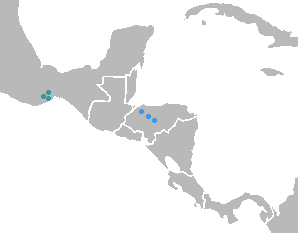
Tequistlatec, also called Chontal, are three close but distinct languages spoken or once spoken by the Chontal people of Oaxaca State, Mexico.
The Totonacan languages are a family of closely related languages spoken by approximately 290,000 Totonac and Tepehua people in the states of Veracruz, Puebla, and Hidalgo in Mexico. At the time of the Spanish conquest Totonacan languages were spoken all along the gulf coast of Mexico. During the colonial period, Totonacan languages were occasionally written and at least one grammar was produced. In the 20th century the number of speakers of most varieties have dwindled as indigenous identity increasingly became stigmatized encouraging speakers to adopt Spanish as their main language.

Myriam Moscona is a Mexican journalist, translator and poet in the Ladino and Spanish languages who comes from a Bulgarian Sephardi Jewish family. She teaches at Miami University. She was the artist in-residence from the Banff Centre for the Arts in 2000.
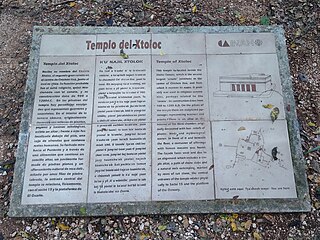
The Constitution of Mexico does not declare an official language; however, Spanish is the de facto national language spoken by over 99% of the population making it the largest Spanish speaking country in the world. The government also recognizes 63 indigenous languages spoken in their communities out of respect, including Nahuatl, Mayan, Mixtec, etc.

Indigenous peoples of Mexico, Native Mexicans or Mexican Native Americans, are those who are part of communities that trace their roots back to populations and communities that existed in what is now Mexico before the arrival of Europeans.
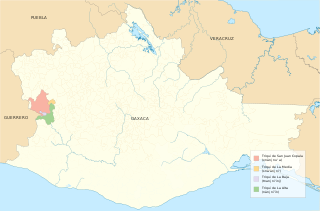
The Triqui, or Trique, languages are a family of Oto-Manguean spoken by 30,000 Trique people of the Mexican states of Oaxaca and the state of Baja California in 2007. They are also spoken by 5,000 immigrants to the United States. Triqui languages belong to the Mixtecan branch together with the Mixtec languages and Cuicatec.
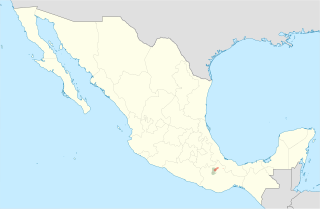
Cuicatec is an Oto-Manguean language spoken in Oaxaca, Mexico. It belongs to the Mixtecan branch together with the Mixtec languages and the Trique language. The Ethnologue lists two major dialects of Cuicatec: Tepeuxila Cuicatec and Teutila Cuicatec. Like other Oto-Manguean languages, Cuicatec is tonal.
Huave is a language isolate spoken by the indigenous Huave people on the Pacific coast of the Mexican state of Oaxaca. The language is spoken in four villages on the Isthmus of Tehuantepec, in the southeast of the state, by around 20,000 people.

Huamelulpan is an archaeological site of the Mixtec culture, located in the town of San Martín Huamelulpan at an elevation of 2,218 metres (7,277 ft), about 96 kilometres (60 mi) north-west of the city of Oaxaca, the capital of Oaxaca state.

The Mixtecan languages constitute a branch of the Oto-Manguean language family of Mexico. They include the Trique languages, spoken by about 24,500 people; Cuicatec, spoken by about 15,000 people; and the large expanse of Mixtec languages, spoken by about 511,000 people. The relationship between Trique, Cuicatec, and Mixtec, is an open question. Unpublished research by Terrence Kaufman in the 1980s supported grouping Cuicatec and Mixtec together.
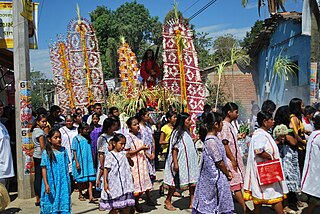
The Amuzgos are an indigenous people of Mexico. They primarily live in a region along the Guerrero/Oaxaca border, chiefly in and around four municipalities: Xochistlahuaca, Tlacoachistlahuaca and Ometepec in Guerrero, and San Pedro Amuzgos in Oaxaca. Their languages are similar to those of the Mixtec, and their territories overlap. They once dominated a larger area, from La Montaña down to the Costa Chica of Guerrero and Oaxaca, but Mixtec expansion, rule and later Spanish colonization has pushed them into the more inaccessible mountain regions and away from the coast. The Amuzgos maintain much of their language and dress and are known for their textiles, handwoven on backstrap looms with very intricate two-dimensional designs. The Amuzgo area is very poor with an economy mostly dependent on subsistence agriculture and handcraft production.
Tepeuxila Cuicatec is a language spoken in Oaxaca State, Mexico.
Teutila Cuicatec is a language spoken in Oaxaca State, Mexico.
Cuicatec may refer to:
Cuitlatec may refer to: